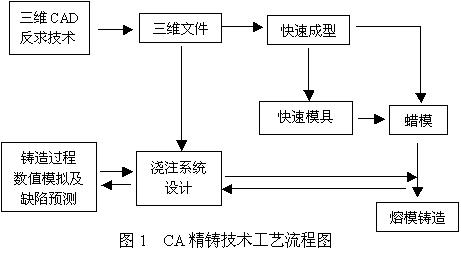Abstract: This paper introduces the CA precision casting process. The application of computer-aided engineering, including three-dimensional CAD and numerical simulation of solidification process, in the development of precision castings is emphasized. IDEAS can easily perform 3D design or reverse engineering, obtain 3D models, and then quickly obtain casting prototypes by rapid prototyping technology; ProCast simulates the casting process of castings to optimize casting parameters and eliminate casting defects.
Keywords: CA Precision Casting Computer Aided Engineering 1 INTRODUCTION <br> <br> precision casting is a model of the cast molding method with soluble (melt). The biggest advantage of precision casting is that the surface is smooth and the size is accurate. The disadvantages are complicated process, long production cycle, many factors affecting the quality of castings, and strict requirements on materials and processes in production [1]. Mold design and manufacturing takes a long time in the production process. The design and manufacture of a complex thin-walled mold can take a year or more. With the advancement of the world industry and the improvement of people's living standards, the product development cycle is getting shorter and shorter, and the design requires a short response time. Especially when the structural design needs to be modified, the previous mold manufacturing costs and manufacturing schedules are wasted. Therefore, mold design and manufacturing have become the bottleneck of new product development. The development of computer-aided engineering has made it possible to integrate traditional industries with new technologies. 3D CAD can free the design from the drawing board, greatly simplifying the designer's design process and reducing the chance of errors. And with the rapid prototyping (RP) technology, especially the development of the laser selective sintering process (SLS) [2, 3, 4], the 3D model can be quickly transformed into the prototype required for precision casting by RP equipment, breaking the mold design. The bottleneck. In addition, in the traditional casting, a new casting is developed. The process setting needs to pass several tests and repeatedly explore. Finally, according to the casting results of various test schemes, the casting process plan that can meet the design requirements is selected. It takes a lot of manpower, material resources and financial resources for many trial castings. Numerical simulation of solidification process can guide the optimization of casting process parameters, predict the number and location of defects, and effectively improve the yield of castings. CA precision casting technology is the application of computer-aided engineering to the precision casting process, combined with other advanced casting technology, to complete the development and trial production of complex products with high quality, low cost and short cycle. At present, the use of CA precision casting technology has completed the trial production of a variety of key components such as aerospace, aviation and weapons, and achieved satisfactory results.
2 Materials and experimental methods CA casting can be applied to stainless steel, heat-resistant steel, high-temperature alloy, aluminum alloy and other alloys. The CA casting process is shown in Figure 1. The 3D model can be designed by 3D design software such as IDEAS, UGII, PROE, etc. The process structure and model conversion are processed and repaired by MagicRp, prototyped on AFSMZ320 automatic forming system, and the surface treatment of the prototype is carried out by melt infiltration. The simulation was performed using PROCAST and finite difference software.

3 CA casting process and key issues related technical discussions <br> <br> recent years, associated with the CA casting technology of three-dimensional CAD design, reverse engineering, rapid prototyping, casting CAD system, numerical simulation of casting process (CPS) And the monomer technology such as special casting has made great progress. The achievement of these achievements laid the foundation for the formation of integrated CA casting technology and promoted the rapid development and application of CA precision casting technology. In order for each monomer technology to be successfully used in CA casting, it is necessary to eliminate the interface between each other and organically combine these technologies. Therefore, in the product development, we can achieve advanced design in the true sense + advanced materials + advanced manufacturing.
Next page
Pressure sensor usually consists of a pressure sensor and a signal processing unit for measuring the pressure of liquids and gases. According to different test pressure types, pressure sensors can be divided into gauge pressure sensors, differential pressure sensors and absolute pressure sensors. According to the working principle, it can be divided into Ceramic Pressure Sensor, diffusion silicon pressure sensor, piezoresistive pressure sensor, sapphire pressure sensor and so on.
Pressure Sensor,Miniature Pressure Transducer,Pressure Transducer,Hydraulic Pressure Transducer,pressure transmitter
Xi'an Gavin Electronic Technology Co., Ltd , https://www.cngamicos.com